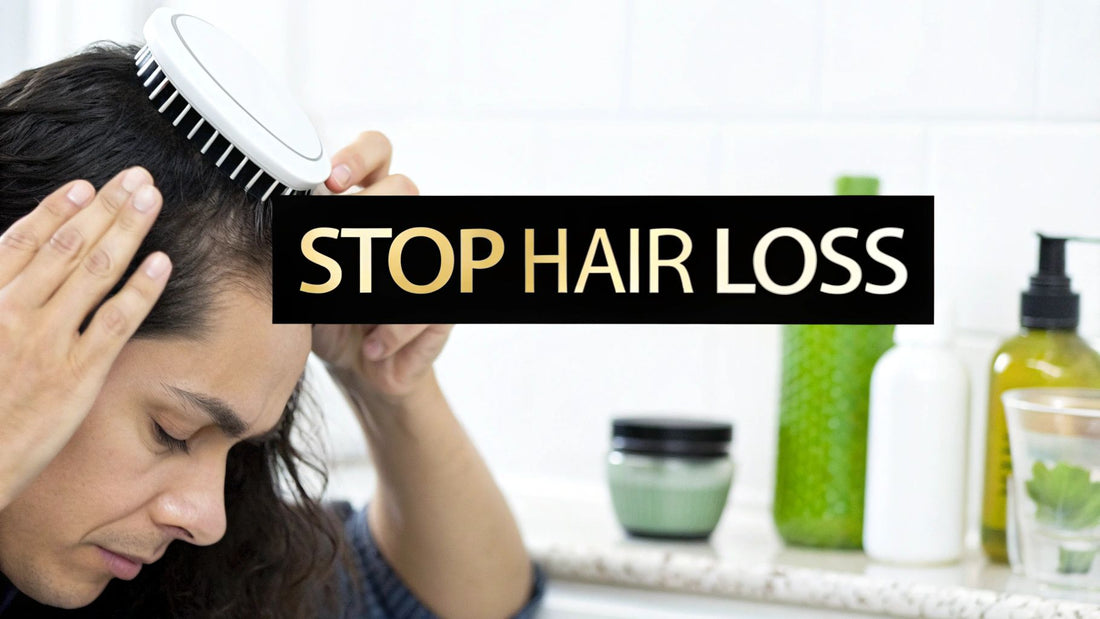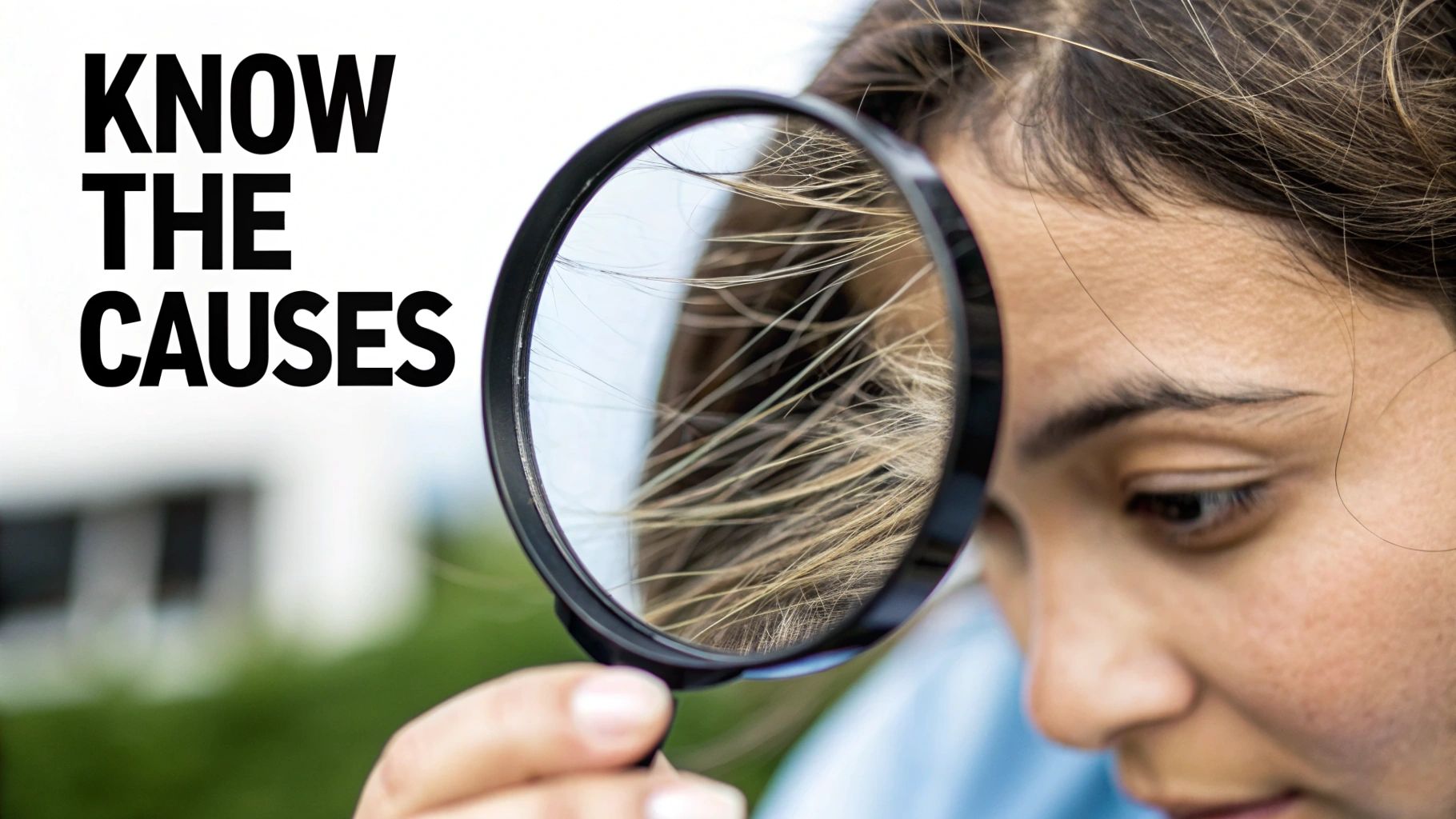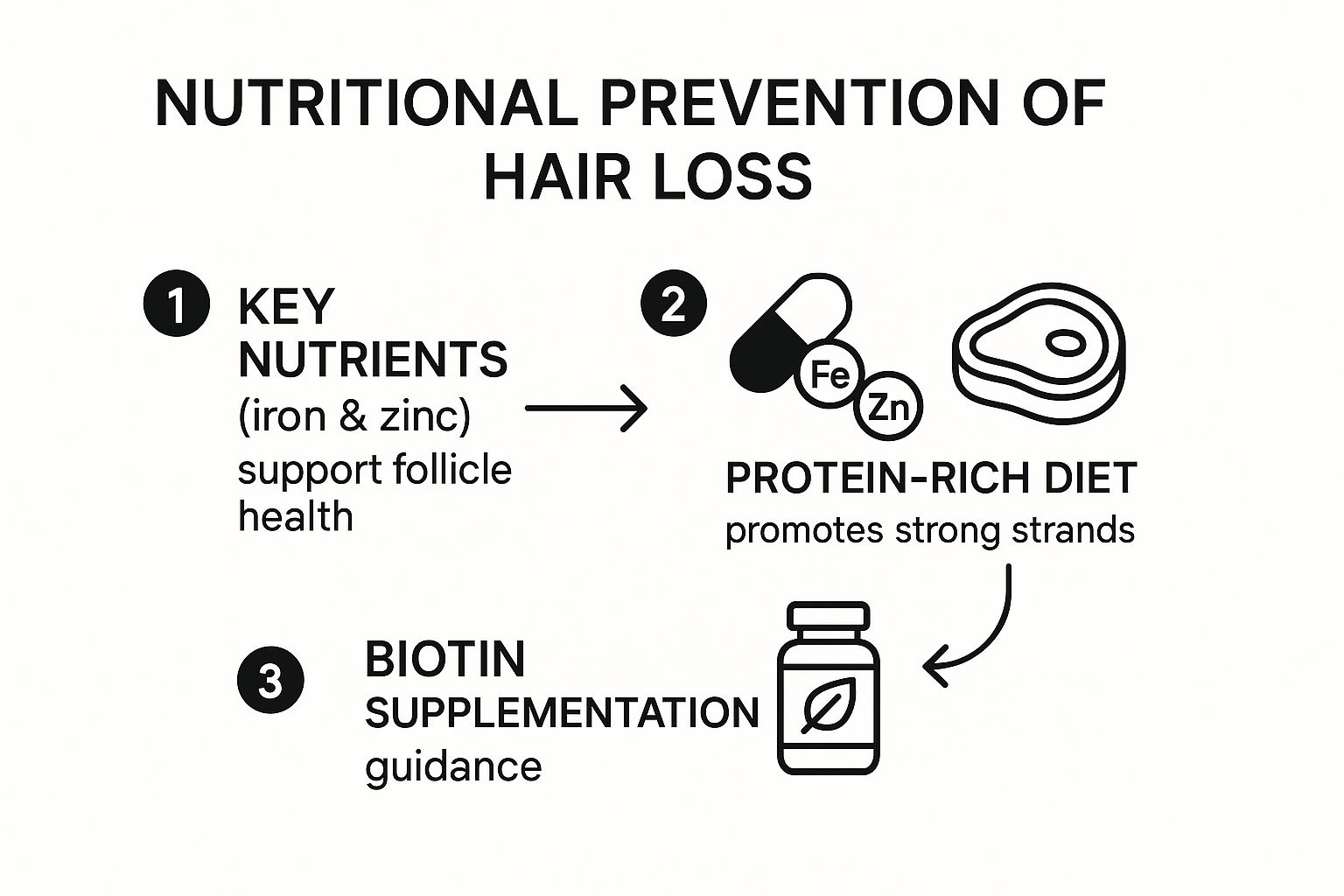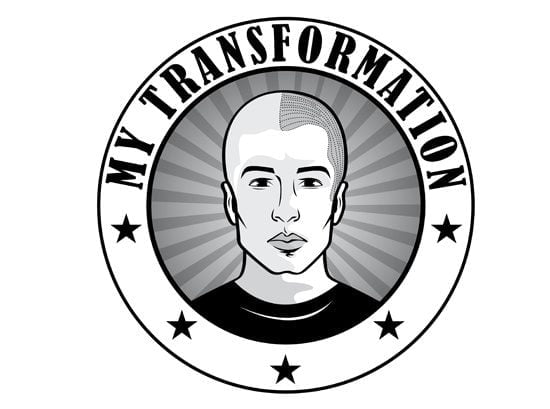
A Guide on How to Stop Hair Loss in Australia
Share
Figuring out how to stop hair loss often starts with one simple question: "Why is this happening to me?" The answer isn't always straightforward. It could be your genes, hormonal shifts, or even lifestyle factors like stress and what you eat. Getting to the bottom of the real reason your hair is thinning is the only way to find a solution that actually works.
Why Hair Loss Happens in Australia

Before we can even think about tackling hair loss, we need to understand what's causing it. For a lot of Aussie blokes, the answer lies in their family tree.
The Role of Genetics and Environment
Male-pattern baldness, or androgenetic alopecia as it's clinically known, is far and away the most common type of hair loss we see down under. It impacts a staggering 50% of men by the time they hit 50, and that number jumps to about 80% by age 70. It’s an inherited trait where your hair follicles are just extra sensitive to a hormone called DHT, causing them to shrink over time.
But it’s not just about genetics. Our unique Aussie lifestyle and environment can make things worse. Australia's notoriously high UV index means our scalps get a real beating from the sun. This constant exposure can damage hair follicles and aggravate scalp conditions, which can definitely speed up the thinning process. It’s a bit of a double whammy: a genetic predisposition mixed with harsh environmental factors.
Lifestyle and Hormonal Triggers
Beyond the sun and your genes, modern life has its own ways of messing with your hair. High-stress jobs, personal worries—it all adds up. This can trigger a condition called telogen effluvium, where a huge chunk of your hair suddenly enters the shedding phase all at once. If that sounds familiar, you can get more details here: https://www.mytransformation.com.au/blogs/news/stress-related-hair-loss.
Hormonal imbalances are another massive piece of the puzzle for both men and women. These shifts can happen for all sorts of reasons, from different life stages to underlying health issues. Even things we don't think about, like exposure to endocrine disruptors in food, can throw your hormones out of whack and contribute to hair loss.
To help you get a clearer picture, here’s a quick rundown of the common culprits we see in Australia.
Common Hair Loss Triggers for Australians
| Factor Type | Specific Trigger | How It Affects Hair |
|---|---|---|
| Genetics | Androgenetic Alopecia | Inherited sensitivity to DHT shrinks hair follicles, leading to permanent thinning. |
| Environmental | High UV Exposure | Sun damage weakens hair shafts and can harm the scalp's health, accelerating hair loss. |
| Lifestyle | Chronic Stress | Triggers telogen effluvium, causing a large number of hairs to enter the shedding phase. |
| Hormonal | Fluctuations & Imbalances | Disrupts the normal hair growth cycle, often seen during major life changes or due to diet. |
| Dietary | Nutritional Deficiencies | Lack of key vitamins and minerals like iron and biotin can starve follicles and inhibit growth. |
Identifying your specific trigger from this list is the first real step toward finding an effective solution.
The most crucial part of any hair loss journey is figuring out exactly what you're dealing with. Is it genetic, stress-related, or something else entirely? Pinpointing the cause is the only way to choose a treatment plan that has a real chance of success.
Once you have a better idea of what's behind your hair loss, you can stop wasting time on generic products and start focusing on a personalised approach that truly addresses your situation. This knowledge is what empowers you to make the right choices for getting your hair back.
Building a Hair-Healthy Lifestyle and Diet
Beyond any specialised treatments, the daily choices you make are the real foundation of your hair's health. You'd be surprised what a difference simple, consistent shifts in your diet and lifestyle can make. This is all about creating an internal environment where your hair can actually thrive, building a proactive defence against hair loss from the inside out.
Your hair is made of a protein called keratin. It’s as simple as this: if your diet is short on protein, your body will divert what little it has to more essential functions, and your hair growth will be the first thing to suffer. Getting enough high-quality protein in your meals is non-negotiable for strong, healthy hair.
Think lean meats, chicken, fish, eggs, and dairy. If you're plant-based, lentils, chickpeas, tofu, and quinoa are all excellent choices you can find in any Aussie supermarket. Getting your head around how to calculate daily protein needs can be a real game-changer.
Fuelling Your Follicles with Key Nutrients
Of course, protein is just one piece of the puzzle. A handful of specific vitamins and minerals play a huge role in the hair growth cycle. In fact, deficiencies in these key nutrients are a common—and often overlooked—cause of thinning hair.
Two of the most important minerals to focus on are iron and zinc. Iron helps your red blood cells shuttle oxygen to your follicles, a process that’s absolutely vital for growth. Zinc, on the other hand, is crucial for hair tissue growth and repair, and it helps keep the oil glands around the follicles working as they should.
This image really breaks down how key nutrients, a protein-rich diet, and targeted supplementation can all work together to keep your hair where it belongs.

As you can see, a holistic approach that combines these foundational nutrients with plenty of protein is what creates the best possible conditions for healthy hair.
To give your diet a boost, start thinking about these powerhouse foods:
- For Iron: Load up on red meat, spinach, lentils, and even fortified cereals. Pro tip: pair these with a source of vitamin C, like oranges or capsicum, to seriously improve how much iron your body absorbs.
- For Zinc: Oysters are the undisputed king of zinc, but beef, pumpkin seeds, and lentils are also fantastic, everyday sources.
A nutrient-rich diet isn't a quick fix; it's a long-term strategy. Think of it as providing the raw materials your body needs to construct strong, resilient hair, day in and day out.
Managing Stress and Simple Hair Care Swaps
It’s no secret that chronic stress is a major enemy of healthy hair. High levels of the stress hormone cortisol can actually shove a huge number of your hair follicles into the shedding phase all at once. You might notice this as a sudden increase in hair falling out a few months after a particularly stressful period.
Weaving simple stress-management techniques into your daily routine can help lower those cortisol levels and get your hair growth cycle back on track. This doesn't have to be complicated—it could be a daily 10-minute mindfulness practice, a brisk walk, or just carving out time for hobbies you genuinely enjoy.
Finally, let's talk about how you physically treat your hair. Aggressive styling and harsh habits can cause breakage that looks a lot like hair loss. Small changes here can really protect your strands:
- Gentle Washing: Focus shampoo on your scalp where the oil and buildup is, and use conditioner mainly on the ends. Washing your hair regularly doesn't cause hair loss; it just keeps your scalp clean and healthy.
- Avoid Tight Styles: That constant pulling from tight ponytails, buns, or braids can lead to a specific type of hair loss called traction alopecia.
- Minimise Heat: Cut back on high-heat styling tools. And when you do use them, always, always use a heat protectant spray first.
These lifestyle tweaks work hand-in-hand with any other treatments you might be considering. While some people might explore a https://www.mytransformation.com.au/blogs/news/hair-tattoo-for-hair-loss to deal with the appearance of thinning, building these foundational habits is what will support the long-term health of the hair you already have.
Your Guide to Over-the-Counter Solutions

When you first decide to do something about your hair loss, walking into a chemist can be pretty daunting. The shelves are packed with products all promising the world, and it's tough to know what's just marketing hype and what actually works. The good news is, there are a few proven, accessible options you can grab without a prescription.
One of the heavy hitters you’ll see is minoxidil. It’s probably the most well-known and researched topical treatment out there. Funnily enough, it started life as a blood pressure medication, but doctors quickly noticed a very welcome side effect—it helped patients regrow their hair.
So, how does it work? Minoxidil helps to widen the blood vessels in your scalp, improving blood flow and nutrient delivery to the hair follicles. It also helps to extend the anagen, or active growth phase, of your hair cycle. In simple terms, it keeps more of your hairs in the growing phase for longer, which can eventually lead to a thicker, fuller head of hair. Just know it's a marathon, not a sprint.
Making Minoxidil Work for You
Getting real results from minoxidil all comes down to being consistent, which is honestly where a lot of people fall short. You have to treat it like any other part of your daily routine, just like brushing your teeth.
Here are a few pointers from my experience:
- Stick With It: You absolutely have to apply it every single day as directed on the bottle. If you start skipping days, you’re just not going to see the results you’re hoping for.
- Scalp, Not Hair: Remember, the target is your skin. Make sure to part your hair in a few spots over the thinning areas and apply the solution directly to your scalp.
- Patience is a Virtue: This is a big one. You won't see a change in the mirror overnight. It usually takes a good 3 to 6 months of daily use before you start to notice any new growth. The best results often appear after about a year of consistent use.
Be prepared for a bit of a shock at the start, too. Many people experience an initial shedding phase around the 2 to 4-week mark. It can be alarming, but it's actually a good sign. It means the minoxidil is working, pushing out the old, weaker hairs to make room for new, healthier ones to grow in.
Exploring Natural Alternatives
While minoxidil is a solid, scientifically-backed option, I get that some people prefer to start with something more natural. While these remedies might not pack the same punch as medical treatments for genetic hair loss, a few have some promising science behind them and can be a fantastic supporting act.
Take rosemary oil, for example. It's gained a lot of buzz lately, and for good reason. Some clinical studies have even shown it can be as effective as a 2% minoxidil solution for androgenetic alopecia. The theory is that it helps to block the hair-thinning hormone DHT right at the scalp.
Another surprisingly effective technique is a simple scalp massage. It feels great, but it also physically stimulates blood circulation to the follicles, helping them get the oxygen and nutrients they need to thrive. You can easily work this into your day when you’re shampooing your hair, or even combine it with a few drops of rosemary oil for a double-whammy treatment.
The thing to remember is that over-the-counter solutions are a brilliant first step. They give you the power to start tackling your hair loss from home, but they demand real commitment. Success comes down to consistency and having realistic expectations.
Whether you go for a proven treatment like minoxidil or a natural approach, sticking with your chosen routine is what will make all the difference. Of course, if you feel you need something more, you can find detailed information about professional hair loss treatment in Perth WA to see what other options are out there.
Taking the Next Step: Medical and Clinical Treatments
When you've tried all the lifestyle tweaks and over-the-counter options but still aren't seeing the results you want, it might be time to look at professional medical treatments. This is where you shift from general hair care to targeted, science-backed interventions. It’s a bigger step, for sure, but for many people, it's the one that truly makes a difference.
These treatments aren't just about supporting hair health; they get right to the root of the problem. They directly intervene in the biological processes that cause hair follicles to shrink and give up. It's a much more direct, and often more powerful, way to manage conditions like male pattern baldness.
Prescription Medications: The DHT Blockers
For most Aussie blokes, the main villain in their hair loss story is Dihydrotestosterone (DHT). This hormone is notorious for shrinking genetically susceptible hair follicles on the scalp. That's where a prescription medication like finasteride comes in. It’s a simple oral tablet that works from the inside out to lower DHT levels throughout your body, essentially shielding your hair follicles from further attack.
The statistics really highlight how common this is. Hair loss is a major concern in Australia, eventually affecting around 85% of men and 33% of women. Of those who decide to seek medical treatment, a massive 66.4% are prescribed finasteride, which shows just how much it's relied on as a first line of defence. For a deeper dive into these numbers, you can find more hair loss statistics over at Medihair.com.
It’s important to remember that finasteride isn’t a one-and-done cure. Think of it as a long-term management plan. You have to take it consistently every day to keep the benefits, because if you stop, your hair loss will likely return to its previous rate within a few months.
Hands-On Clinic Therapies
Beyond a daily pill, specialised clinics offer procedures that work directly on the scalp to kickstart follicle activity. These treatments are less about messing with hormones and more about creating the perfect conditions for hair to grow.
-
Low-Level Laser Therapy (LLLT): This is a completely non-invasive treatment where medical-grade lasers deliver photons into the scalp tissue. Weak cells absorb this light energy, which helps them get healthier and boosts blood flow. This process can be enough to wake up dormant follicles and nudge them back into their growth phase.
-
Platelet-Rich Plasma (PRP): You might have heard this called 'liquid gold'. A small amount of your blood is taken, then spun in a centrifuge to separate and concentrate the platelets, which are packed with natural growth factors. This concentrated plasma is then injected back into your scalp, using your body's own healing power to repair damaged follicles and encourage new growth.
Surgical Solutions: The Hair Transplant
If you're looking for a permanent way to bring hair back to bald or thinning spots, a hair transplant is considered the gold standard. The two most common techniques you’ll hear about are Follicular Unit Transplantation (FUT) and Follicular Unit Extraction (FUE). Both methods involve the same basic idea: moving your own DHT-resistant hair follicles from the back and sides of your head to the thinning areas on top.
With FUE, individual follicular units are carefully extracted one by one, leaving almost no noticeable scarring. FUT, sometimes called the 'strip method', involves taking a small strip of tissue from the donor area, from which the follicles are then separated for transplanting. While a transplant doesn't stop the underlying process of hair loss, it physically restores hair with results that look incredibly natural and are designed to last a lifetime.
For those who might not be a good fit for surgery or are looking for a non-surgical alternative, it's worth comparing the options. You might want to explore information on scalp micropigmentation cost to get a full picture of all the paths available to you.
Considering Scalp Micropigmentation

If you're looking for a more immediate cosmetic fix for hair loss, medical treatments aren't your only option. Scalp Micropigmentation (SMP) is a clever, non-surgical solution that restores the look of a full head of hair, giving you a clean-shaven style that completely masks thinning or bald patches.
Think of it less as a hair growth treatment and more as a hair replication one. A highly trained practitioner uses specialised pigments to tattoo thousands of tiny dots across the scalp. These dots are layered and blended with incredible precision to mimic the appearance of natural hair follicles. The final result? A seamless illusion of a sharp 'buzz cut'.
Who is an Ideal Candidate for SMP?
One of the best things about SMP is its versatility. It's a fantastic option for a wide range of people, not just those with significant balding.
Here are a few common scenarios where it works wonders:
- Receding Hairlines: SMP is brilliant for rebuilding a stronger, more defined hairline that better frames your face.
- Overall Thinning: If your hair is thinning all over, SMP adds the appearance of density between your existing strands, making your hair look much fuller.
- Scar Camouflage: It's an excellent way to conceal scars, whether from an old injury or a previous hair transplant surgery (like the strip scars from FUT procedures).
Because the technique works with any skin tone and hair colour, it’s a genuinely viable option for almost everyone. It provides a reliable and long-lasting solution without the daily grind of medications or the hefty cost of surgery. If you want to dig deeper into what makes it so effective, you can explore why scalp micropigmentation is the answer to hair loss.
The biggest advantage of SMP is the immediate control it gives you. You aren't waiting around for months, hoping your follicles respond to a treatment. You're creating a guaranteed look that can restore your confidence right from the first session.
The whole process usually takes two to four sessions, each lasting a few hours. These are scheduled a couple of weeks apart to give the scalp time to heal and the pigment to settle in naturally.
Longevity is another huge plus. You can expect the results to last four to six years—sometimes even longer—before a simple touch-up is needed to keep it looking fresh. The key, of course, is finding a skilled and experienced practitioner here in Australia. Their artistry is what truly makes the final look indistinguishable from real hair.
Got Questions About Stopping Hair Loss? You're Not Alone.
When you first start looking into ways to stop hair loss, it’s easy to feel like you’ve fallen down a rabbit hole of confusing information. It's a journey many people are on, and it's completely normal to have a ton of questions. Let’s cut through the noise and get you some straight answers.
One of the first things everyone wants to know is whether you can actually stop or reverse hair loss. The short answer? Yes, in many situations, you absolutely can. You can slow it right down, halt it in its tracks, or even see some regrowth, especially if you act early. The key is figuring out why it's happening.
For instance, genetic hair loss (androgenetic alopecia) responds incredibly well to proven treatments. If your hair loss is triggered by something like stress or a nutritional deficiency, you can often reverse it completely just by fixing the underlying problem. The main takeaway here is that taking consistent action sooner rather than later gives you the best possible chance of success.
How Long Before I Actually See a Difference?
This is where you need to play the long game. Patience is a virtue, and it's non-negotiable when treating hair loss.
Whether you're using a topical solution like minoxidil or taking a prescribed medication, you're looking at 3 to 6 months of daily, consistent use before you'll notice the first whispers of new growth. For the full, undeniable results, you’ll want to give it about a year.
It's a marathon, not a sprint. Your hair grows in cycles, and it takes time for any treatment to kick those follicles into a healthier new rhythm and for the new strands to grow long enough to make a real visual impact.
Do Natural Remedies for Hair Loss Really Work?
Some natural approaches have shown some real promise, but it’s important to set realistic expectations. Their effectiveness can be a bit of a mixed bag.
For example, a few studies have suggested that rosemary oil could be as effective as 2% minoxidil for some people. And things like regular scalp massages are fantastic for boosting circulation to the follicles, which is always a good thing.
However, if you're up against more aggressive, genetically-driven hair loss, these natural remedies usually can't pack the same punch as medically-proven treatments. Think of them as excellent supporting players in your overall strategy, working alongside the main treatment plan you've worked out with your doctor.
It’s clear this is a major concern for many. The Australian hair loss treatment market was valued at a whopping USD 133.84 million and is on track to nearly double by 2033. This boom is largely thanks to more men taking a proactive stance against baldness. With about 40.8% of Australian men dealing with hair loss, it’s no wonder so many are seeking solutions. You can dive deeper into the Australian hair loss treatment market growth stats here.
At My Transformation, our focus is on helping you find a solution that lasts. If you’re ready to see how Scalp Micropigmentation can give you back your confidence, come see what we’re all about at https://www.mytransformation.com.au.
